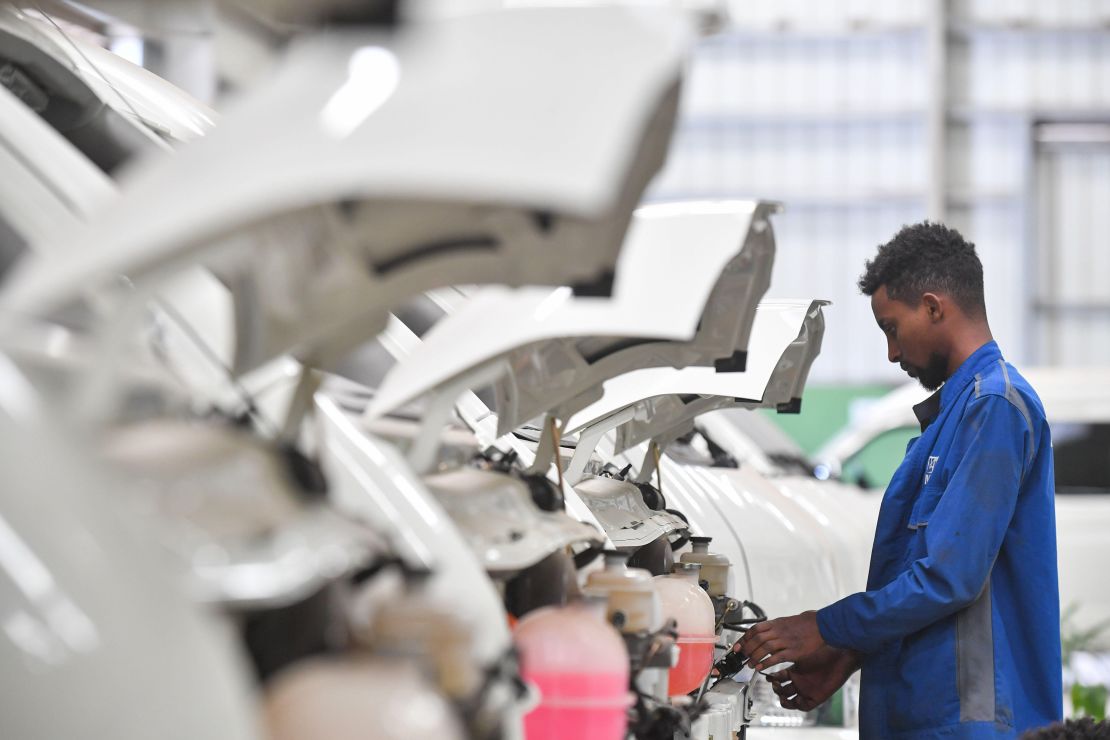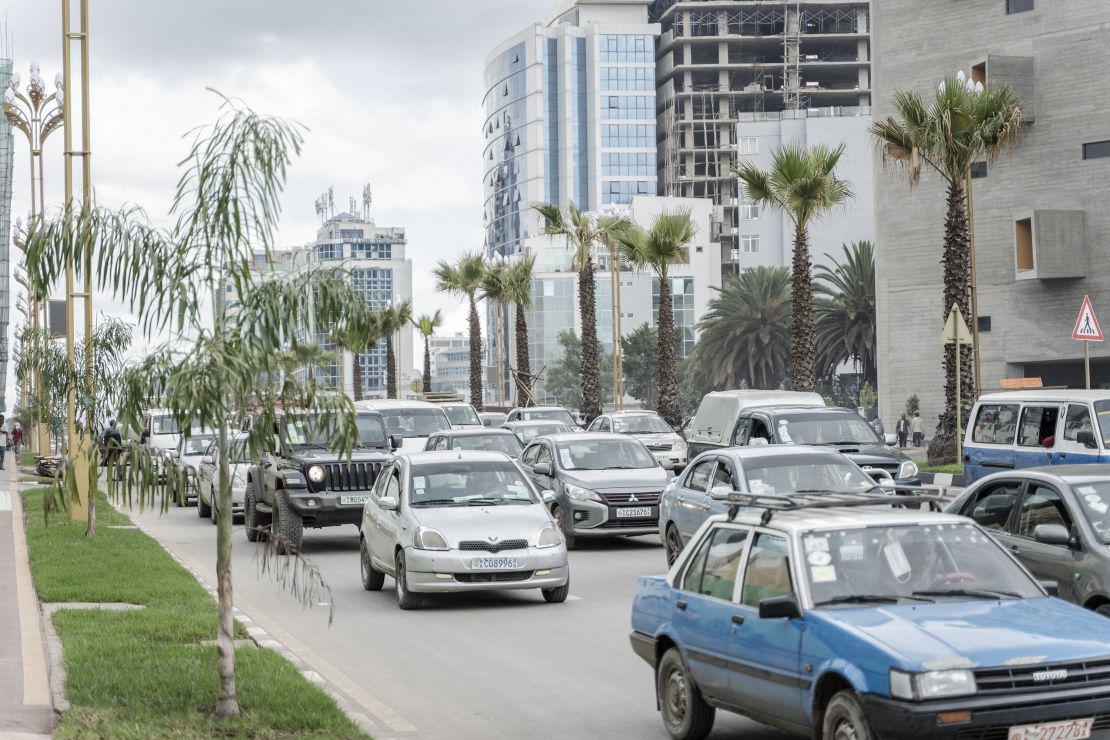CNN
—
Due to fuel shortages and a sharp rise in fuel prices, long queues have formed in front of petrol stations in Ethiopia’s capital, Addis Ababa, in recent months.
But electric car driver Mikial Belayneh avoids them completely.
“I no longer have to queue for petrol on the road,” Belayneh, an Addis resident, told CNN. A full charge of his imported Toyota bZ4X – a popular electric car in the country – “is more than two days’ worth.”
Belayneh, who charges his car at home, is part of the rapid transition to electric vehicles in Addis Ababa, a fast-growing city in the Horn of Africa and the center of Ethiopia’s goal to lift millions out of poverty.
In addition to the polluting cars and trucks rumbling along the streets, cleaner – and quieter – vehicles are now joining the mix. Electric buses, smaller 15-seat minibuses, cars and motorcycles are increasingly appearing on the streets of the capital.
There are currently around 100,000 electric vehicles in Ethiopia.

According to estimates by the Ethiopian government, this number will more than quadruple by 2032. The main reason for this is that earlier this year the government became the first country in the world to take the extraordinary step of banning the import of all petrol-powered passenger vehicles.
In addition, tariffs on imported cars have been drastically reduced: before the ban, the tax on petrol vehicles was up to 200 percent, while the import tax on fully assembled electric vehicles is only 15 percent, according to the country’s finance ministry.
It is part of a government-led initiative to get more electric vehicles on the road.
The lower tariffs are also encouraging local production of electric vehicles. Hundreds of the vehicles were assembled by Ethiopia-based Belayneh Kindie Group using parts imported from China. Besufekad Shewaye, manager of the company, told CNN that import tariffs on electric vehicle parts assembled in Ethiopia are “close to zero percent.”
“Nowadays, most vehicle owners prefer electric vehicles, especially light vehicles,” Shewaye said. “Demand is increasing day by day.”
Ethiopia is relying heavily on electric vehicles, partly because fuel imports are expensive and 96% of the country’s electricity comes from clean hydropower – a double win for the country’s finances and for the environment.
“You really are a clean energy country,” says Jane Akumu, a Kenya-based program officer for the United Nations Environment Programme. “Why are you importing oil when you have local electricity that you can actually use for your vehicles?”
The government realized that the country had abundant renewable energy sources when it began the transition to electric vehicles, says Assefa Hadis Hagos, a transportation consultant at Ethiopia’s Ministry of Transport and Logistics.
Still, the total ban on imports of petrol cars imposed in January surprised many in the region. “We didn’t know that the government would fully support a total ban,” Akumu said.

Ethiopia, which has been ruled for years by an authoritarian one-party government, has shown that it can quickly implement environmental policies that would likely take longer in more democratic countries. In the early 2000s, the country quickly banned inefficient and dangerous leaded gasoline.
“Other countries need more consultation processes and more participation,” said Akumu, who also led efforts to eradicate leaded gasoline in Africa.
The number of cars on Ethiopia’s roads is still quite low. It totals around 1.2 million, or one car per 1,000 people.
In the United States, more than 91 percent of Americans own at least one car. In Africa’s most populous country, Nigeria, the total is 11.8 million cars, or about 54 cars per 1,000 people. The Ethiopian government had kept car ownership rates low by dramatically high taxes on gasoline-powered vehicles, costing consumers up to three times the value of imported cars – part of an effort to get more people to use public transportation.
Although the government has reduced or eliminated some taxes on imported electric cars, buying an electric car is still expensive. “As far as electric car buyers go, it’s definitely the high-income groups,” says Iman Abubaker, who lives in Ethiopia and works on sustainable transportation for the World Resources Institute, a global nonprofit.
That’s why Abubakers and other groups are working to encourage the Ethiopian government and other governments across the continent to invest more in electric buses and public transportation so that the efficient vehicles can be used by people of all income levels.
Despite the cost, Ethiopia’s vehicle fleet has seen a gradual but steady increase in the number of electric vehicles displacing internal combustion engine cars. According to CleanTechnica, electric vehicles already account for nearly 10% of vehicles within two years of the country’s 10-year goal of bringing more than 100,000 electric vehicles into the country – which began in 2022.
The Ethiopian government is satisfied with the pace of the transition, transport consultant Hagos told CNN, adding that the government is “committed” to reducing climate and environmental pollution from gasoline-powered cars.
Electric buses and Wedding
Currently, Ethiopia is the only country with a ban on imports of gasoline-powered cars. The country’s ban is “definitely a one-off,” said Moses Nderitu, the Kenyan managing director of electric bus company BasiGo.
But even without such bans, the number of electric vehicles on the continent is growing. In Nairobi, Kenya, electric motorcycles are experiencing astonishing growth. Last year, Uber launched a fleet of eye-catching yellow motorcycles, known locally as boda bodas.
After the Kenyan government passed tax breaks, the number of electric motorcycles on the roads increased by 500% in a single year, industry experts told CNN. From a few hundred motorcycles, the number on Nairobi’s streets increased to around 3,000.
While that number is still only a small fraction of the 200,000 bicycles on Nairobi’s streets, it has already helped reduce noise pollution in parts of the city, says Hezbon Mose, the Kenya country director of e-bike company Ampersand, which has bike fleets in both Kenya and Rwanda.
In the Ethiopian capital, city authorities have taken stricter measures, including banning the issuing of driving licenses for gasoline-powered motorcycles. In April, they approved a timetable for converting gasoline-powered motorcycles to electric-powered models.

At the beginning of March, the city introduced its first fleet of electric buses for public transport.
American-style electric public buses – more monotonous than the colorful and musically powered petrol-powered buses Matatu – A day without children Buses in Kenya are also increasingly driving on the streets of Nairobi.
Both Mose and Nderitu see a rise in electric cars across the continent as some countries look to move away from oil and use cheaper electricity instead. Getting more people to switch to electric cars will require much more infrastructure and government subsidies in many countries.
“I look at electric vehicles the same way I looked at the mobile phone market 30 years ago,” Nderitu told CNN. “When the rest of the world started adopting mobile phones, there was no infrastructure (in Africa). There were very few people who had a phone. If you look at Nairobi today, you’ll hardly find anyone without a phone.”

